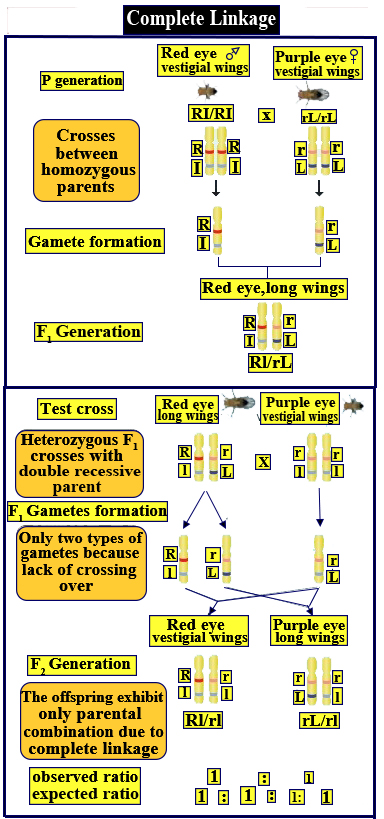Answer
414.6k+ views
Hint: Complete linkage is found in organisms that are also known as small fruit flies. In fruit fly also it is present only in one sex which has rounded genitalia at the tip of their abdomen.
Complete step by step answer:
- The arrangement of genes or the sequences of the DNA on the same chromosomes together and close is called linkage.
- Complete linkage is found in Male drosophila. Male drosophila is generally smaller than the female drosophila.

- If there is a complete linkage present, the chances of crossing over reduce to a minimum or do not take place just because of the arrangement or position of alleles.
So, the correct answer is ‘Male drosophila '.
Additional Information: Complete linkage is defined as the state within which two loci are so close that alleles of those loci are virtually not possible to be separated during crossing over. In the case of male Drosophila, there's the complete absence of recombinant types because of the absence of crossover. This suggests that every one of the genes that start out on one chromosome, will find themselves thereon on the same chromosome in their original configuration. When there is the absence of recombination, only parental phenotypes are expected. The chances of two genes to get separated during crossing over depends on the physical location of the two genes. If genes are closer than there is less chance of separation after crossing over. The genome of D. melanogaster contains four pairs of chromosomes which are, X/Y pair, and three autosomes labeled 2, 3, and 4. The fourth chromosome is so tiny, it's often ignored, apart from its important eyeless gene.
Note: Both male and feminine D. melanogaster fly act polygamously which means having multiple sexual partners at a similar time. In both males and females, polygamy leads to a decrease in evening activity compared to virgin flies, more so in males than females.
Complete step by step answer:
- The arrangement of genes or the sequences of the DNA on the same chromosomes together and close is called linkage.
- Complete linkage is found in Male drosophila. Male drosophila is generally smaller than the female drosophila.

- If there is a complete linkage present, the chances of crossing over reduce to a minimum or do not take place just because of the arrangement or position of alleles.
So, the correct answer is ‘Male drosophila '.
Additional Information: Complete linkage is defined as the state within which two loci are so close that alleles of those loci are virtually not possible to be separated during crossing over. In the case of male Drosophila, there's the complete absence of recombinant types because of the absence of crossover. This suggests that every one of the genes that start out on one chromosome, will find themselves thereon on the same chromosome in their original configuration. When there is the absence of recombination, only parental phenotypes are expected. The chances of two genes to get separated during crossing over depends on the physical location of the two genes. If genes are closer than there is less chance of separation after crossing over. The genome of D. melanogaster contains four pairs of chromosomes which are, X/Y pair, and three autosomes labeled 2, 3, and 4. The fourth chromosome is so tiny, it's often ignored, apart from its important eyeless gene.
Note: Both male and feminine D. melanogaster fly act polygamously which means having multiple sexual partners at a similar time. In both males and females, polygamy leads to a decrease in evening activity compared to virgin flies, more so in males than females.
Recently Updated Pages
How many sigma and pi bonds are present in HCequiv class 11 chemistry CBSE

Why Are Noble Gases NonReactive class 11 chemistry CBSE

Let X and Y be the sets of all positive divisors of class 11 maths CBSE

Let x and y be 2 real numbers which satisfy the equations class 11 maths CBSE

Let x 4log 2sqrt 9k 1 + 7 and y dfrac132log 2sqrt5 class 11 maths CBSE

Let x22ax+b20 and x22bx+a20 be two equations Then the class 11 maths CBSE

Trending doubts
Fill the blanks with the suitable prepositions 1 The class 9 english CBSE

At which age domestication of animals started A Neolithic class 11 social science CBSE

Which are the Top 10 Largest Countries of the World?

Give 10 examples for herbs , shrubs , climbers , creepers

Difference between Prokaryotic cell and Eukaryotic class 11 biology CBSE

Difference Between Plant Cell and Animal Cell

Write a letter to the principal requesting him to grant class 10 english CBSE

Change the following sentences into negative and interrogative class 10 english CBSE

Fill in the blanks A 1 lakh ten thousand B 1 million class 9 maths CBSE



